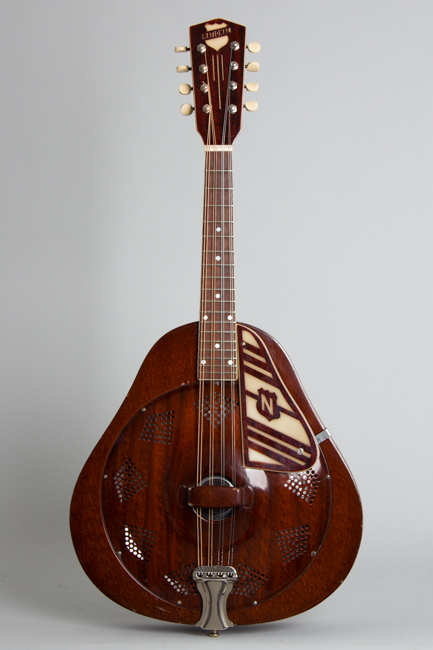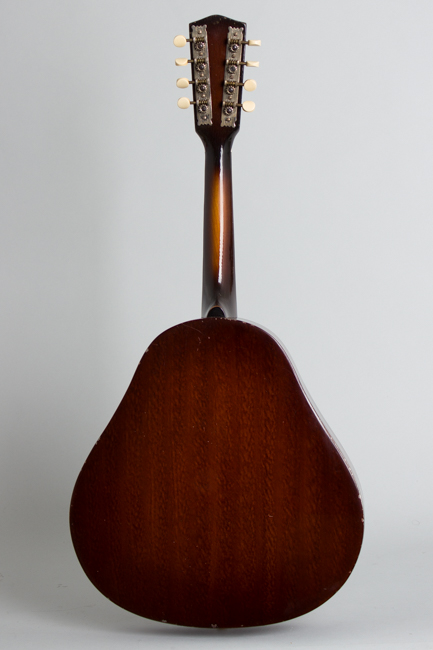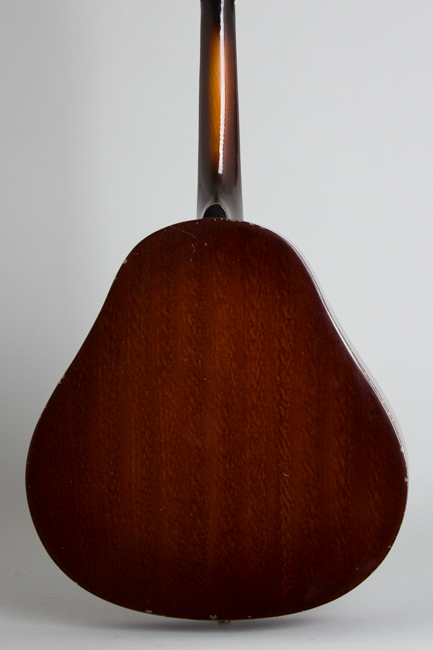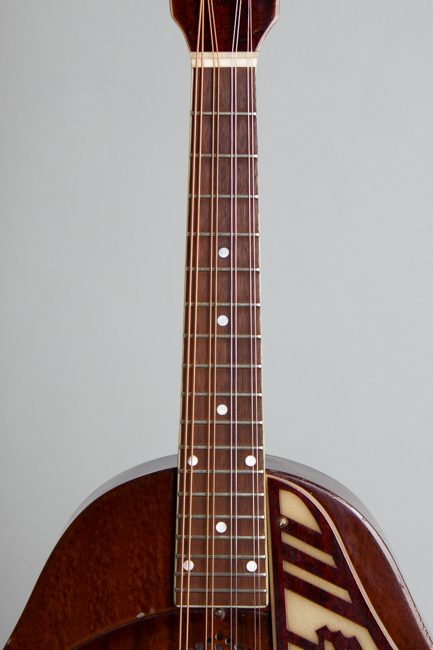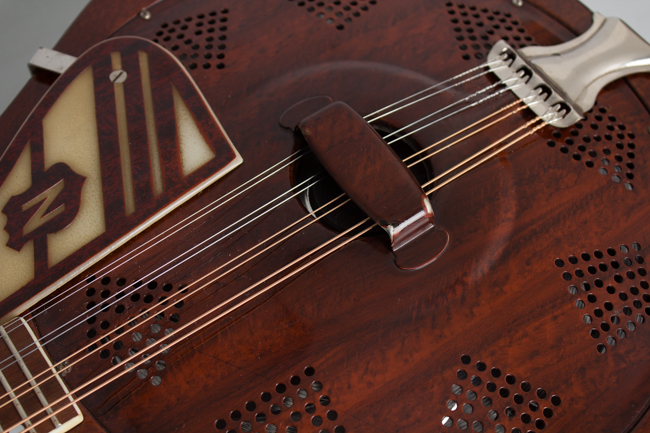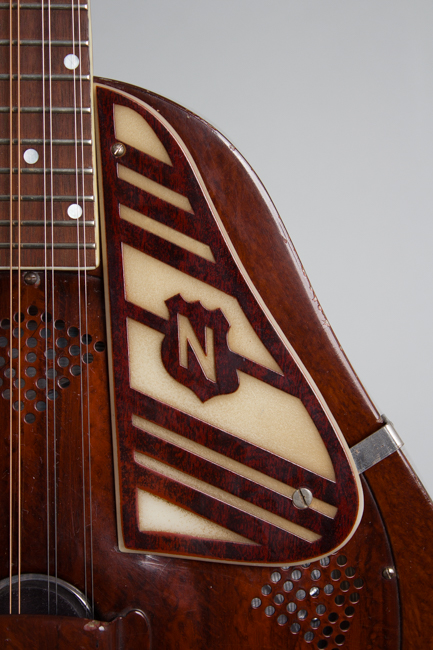National Triolian Resophonic Mandolin (1937)
National Triolian Model Resophonic Mandolin (1937), made in Chicago, serial # B-3625, woodgrain enamel finish, steel body; mahogany neck with rosewood fingerboard, black gig bag case.
This is a nice fine-playing example of an later 1930s National Triolian Mandolin, the most popular of the California company's depression-era 8-string creations. Apparently it was not considered ironic at National to make metal-bodied instruments with a faux wood finish! Both the Triolian mandolins and guitars were styled this way in the later 1930s, and while not as common as earlier models seem to have sold decently well. By this point National had merged with Dobro and were located in Chicago, having forsaken sunny Los Angeles to be closer to the heart of the music industry.
Besides the quixotic woodgrain finish these later Midwest-made Triolians have attractive headstocks faced with engraved plastic, also used for the elevated pickguards. These have cut-through graphics in lovely Art Deco patterns. The slim maple neck sports a bound rosewood fingerboard, a big improvement over the older "ebonized" boards of the early 1930's. The tuners are 1920s style engraved-plate Waverly strips, probably stock bought some years earlier still being used up. The tailpiece is the standard 8-string National style.
With a retail price of $45.00 in the later 1930's, this steel-bodied machine offered a lot of sonic firepower for the player's hard-earned money. This is one of the loudest mandolins you will ever hear, but played more softly can offer a surprisingly rich bell-like tone. This steel-bodied 8-string is perfect for ragtime and jugband styles, and a great match to any wood finish Triolian guitar.
Overall length is 27 in. (68.6 cm.), 12 3/4 in. (32.4 cm.) width, and 2 5/8 in. (6.7 cm.) in depth, measured at side of rim. Scale length is 15 in. (381 mm.). Width of nut is 1 1/4 in. (32 mm.).
This is a nice example overall showing some restoration but an excellent player. The faux woodgrain enamel finish remains all-original in relatively clean and still shiny condition, though it does show some wear with typical chips and dents mostly to the body edges. The handrest on the coverplate has a couple of small spots of enamel rubbed off the edges. The lacquer on the back of the neck is very clean with a couple of small dinks and rubs to the headstock edges.
The neck has been trued and refretted with wire a bit larger than the original pattern. The nut is replaced with a small extra piece of binding added along the top edge. The hardware is mixed; the tuners and tailpiece are original, the cone and biscuit are newer from the modern National company. The plastic pickguard has survived in perfect condition; this version does not outgas and crumble as many do.
This is a very well set up, fine sounding and playing Triolian mandolin, ungodly loud yes but with a rounder and more fluid tone than some. It includes a racquetball racquet case as a gig bag; The body is wider than a standard-shaped mandolin and this is one of the few things that will fit! Overall Very Good + Condition.
This is a nice fine-playing example of an later 1930s National Triolian Mandolin, the most popular of the California company's depression-era 8-string creations. Apparently it was not considered ironic at National to make metal-bodied instruments with a faux wood finish! Both the Triolian mandolins and guitars were styled this way in the later 1930s, and while not as common as earlier models seem to have sold decently well. By this point National had merged with Dobro and were located in Chicago, having forsaken sunny Los Angeles to be closer to the heart of the music industry.
Besides the quixotic woodgrain finish these later Midwest-made Triolians have attractive headstocks faced with engraved plastic, also used for the elevated pickguards. These have cut-through graphics in lovely Art Deco patterns. The slim maple neck sports a bound rosewood fingerboard, a big improvement over the older "ebonized" boards of the early 1930's. The tuners are 1920s style engraved-plate Waverly strips, probably stock bought some years earlier still being used up. The tailpiece is the standard 8-string National style.
With a retail price of $45.00 in the later 1930's, this steel-bodied machine offered a lot of sonic firepower for the player's hard-earned money. This is one of the loudest mandolins you will ever hear, but played more softly can offer a surprisingly rich bell-like tone. This steel-bodied 8-string is perfect for ragtime and jugband styles, and a great match to any wood finish Triolian guitar.
Overall length is 27 in. (68.6 cm.), 12 3/4 in. (32.4 cm.) width, and 2 5/8 in. (6.7 cm.) in depth, measured at side of rim. Scale length is 15 in. (381 mm.). Width of nut is 1 1/4 in. (32 mm.).
This is a nice example overall showing some restoration but an excellent player. The faux woodgrain enamel finish remains all-original in relatively clean and still shiny condition, though it does show some wear with typical chips and dents mostly to the body edges. The handrest on the coverplate has a couple of small spots of enamel rubbed off the edges. The lacquer on the back of the neck is very clean with a couple of small dinks and rubs to the headstock edges.
The neck has been trued and refretted with wire a bit larger than the original pattern. The nut is replaced with a small extra piece of binding added along the top edge. The hardware is mixed; the tuners and tailpiece are original, the cone and biscuit are newer from the modern National company. The plastic pickguard has survived in perfect condition; this version does not outgas and crumble as many do.
This is a very well set up, fine sounding and playing Triolian mandolin, ungodly loud yes but with a rounder and more fluid tone than some. It includes a racquetball racquet case as a gig bag; The body is wider than a standard-shaped mandolin and this is one of the few things that will fit! Overall Very Good + Condition.
